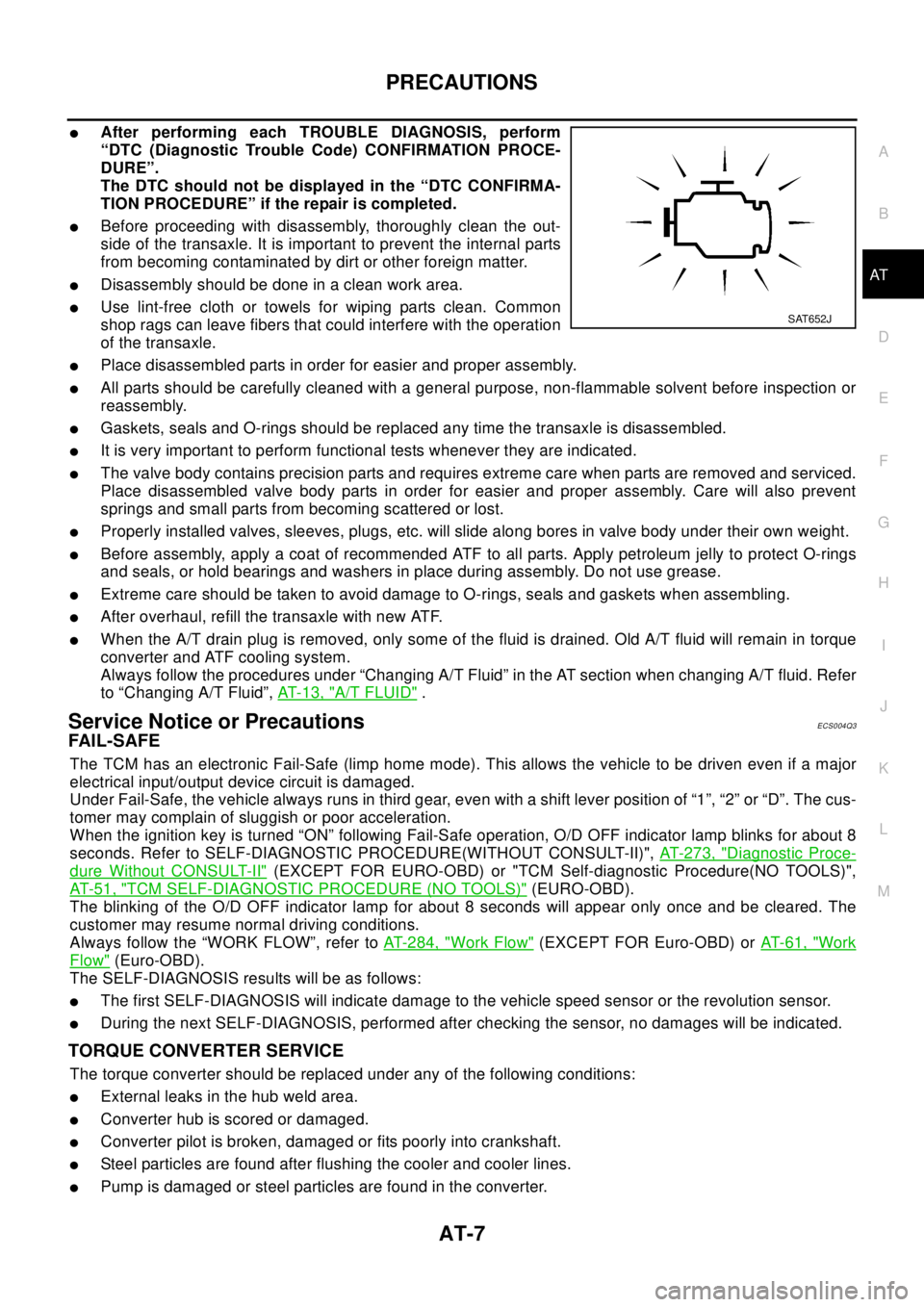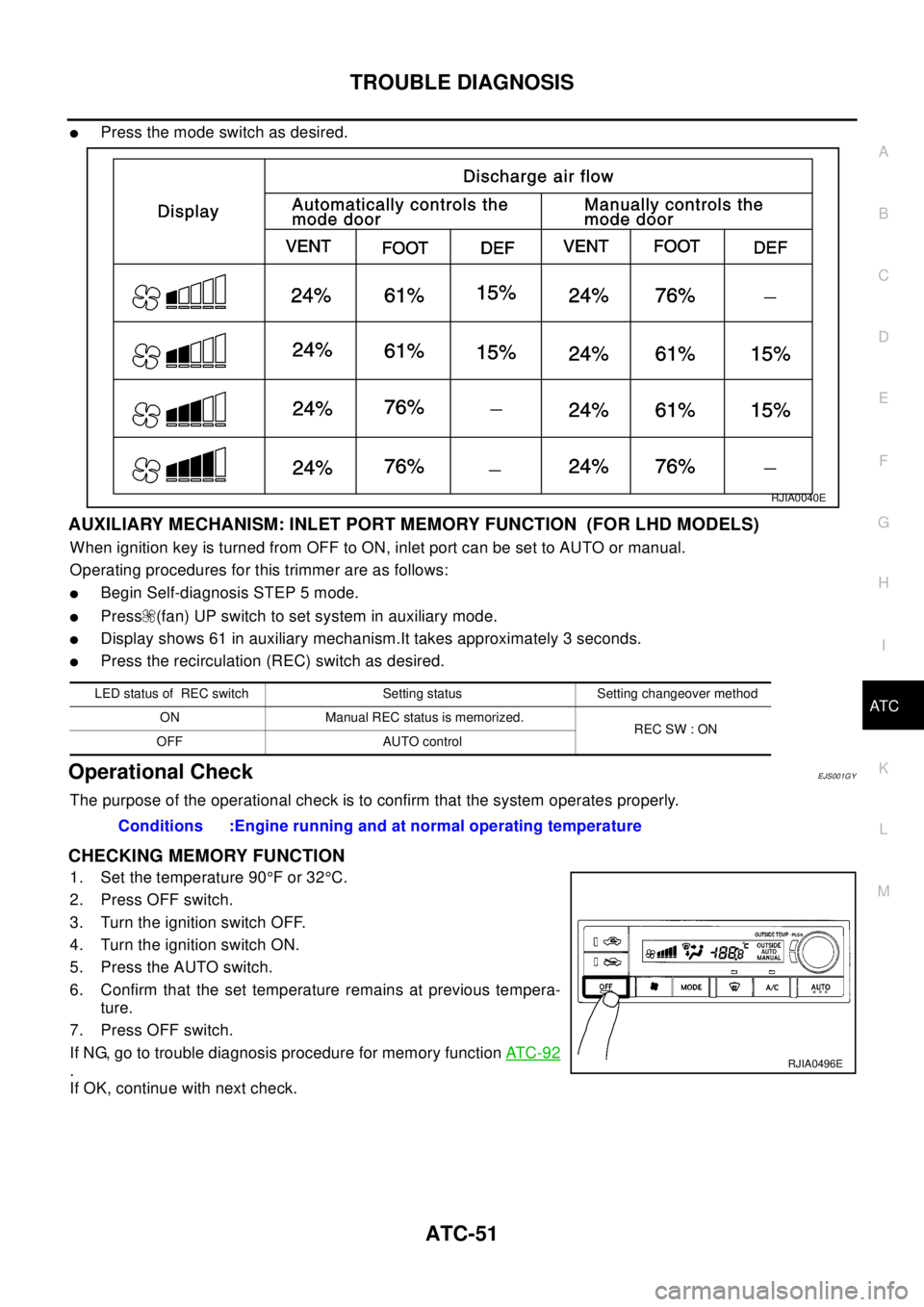key NISSAN X-TRAIL 2003 Electronic Repair Manual
[x] Cancel search | Manufacturer: NISSAN, Model Year: 2003, Model line: X-TRAIL, Model: NISSAN X-TRAIL 2003Pages: 3066, PDF Size: 51.47 MB
Page 9 of 3066

AT-3
D
E
F
G
H
I
J
K
L
MA
B
AT Line Pressure Test ............................................... 290
Road Test ............................................................. 291
TROUBLE DIAGNOSIS — GENERAL DESCRIP-
TION ........................................................................ 308
Symptom Chart .................................................... 308
TCM Terminals and Reference Value ................... 347
CAN COMMUNICATION ........................................ 351
System Description .............................................. 351
TROUBLE DIAGNOSES FOR SYMPTOMS .......... 352
............................................................................. 352
1. O/D OFF Indicator Lamp Does Not Come On . 354
2. Engine Cannot Be Started In “P” and “N” Position. 355
3. In “P” Position, Vehicle Moves Forward Or Back-
ward When Pushed .............................................. 356
4. In “N” Position, Vehicle Moves ......................... 356
5. Large Shock. “N”®“R” Position ...................... 358
6. Vehicle Does Not Creep Backward In “R” Position. 359
7. Vehicle Does Not Creep Forward In “D”, “2” Or
“1” Position ........................................................... 362
8. Vehicle Cannot Be Started From D
1................. 364
9. A/T Does Not Shift: D
1®D2Or Does Not Kick-
down: D
4®D2..................................................... 366
10. A/T Does Not Shift: D
2®D3......................... 368
11.A/TDoesNotShift:D
3®D4.......................... 371
12. A/T Does Not Perform Lock-up ...................... 374
13. A/T Does Not Hold Lock-up Condition ........... 375
14. Lock-up Is Not Released ................................ 376
15. Engine Speed Does Not Return To Idle (Light
Braking D
4®D3) ................................................ 377
16. Vehicle Does Not Start From D
1..................... 379
17. A/T Does Not Shift: D
4®D3, When Overdrive
Control Switch “ON”®“OFF” .............................. 380
18. A/T Does Not Shift: D
3®22, When Selector
Lever “D”®“2” Position ...................................... 380
19. A/T Does Not Shift: 2
2®11, When Selector
Lever “2”®“1” Position ....................................... 381
20. Vehicle Does Not Decelerate By Engine Brake. 381
21. TCM Self-diagnosis Does Not Activate (PNP &
Overdrive Control Switches, and Throttle Position
Sensor Circuit Checks) ........................................ 382
ALL
MAIN POWER SUPPLY AND GROUND CIRCUIT. 389
Wiring Diagram — AT — MAIN ............................ 389
Diagnostic Procedure ........................................... 390
VEHICLE SPEED SENSOR·A/T (REVOLUTION
SENSOR) ................................................................ 392
Description ........................................................... 392
Wiring Diagram — AT — VSSA/T ........................ 394
Diagnostic Procedure ........................................... 395
DTC VEHICLE SPEED SENSOR MTR .................. 397
Description ........................................................... 397
Wiring Diagram — AT — VSSMTR ...................... 399
Diagnostic Procedure ........................................... 400
ACCELE RATOR PEDAL POSITION (APP) SEN-
SOR ........................................................................ 401
Description ........................................................... 401Wiring Diagram — AT — TPS ..............................403
Diagnostic Procedure ...........................................404
SHIFT SOLENOID VALVE A ..................................406
Description ............................................................406
Wiring Diagram — AT — SSV/A ...........................408
Diagnostic Procedure ...........................................409
Component Inspection ..........................................410
SHIFT SOLENOID VALVE B ..................................411
Description ............................................................411
Wiring Diagram — AT — SSV/B ...........................413
Diagnostic Procedure ...........................................414
Component Inspection ..........................................415
OVERRUN CLUTCH SOLENOID VALVE ...............416
Description ............................................................416
Wiring Diagram — AT — OVRCSV ......................418
Diagnostic Procedure ...........................................419
Component Inspection ..........................................420
TORQUE CONVERTER CLUTCH SOLENOID
VALVE .....................................................................421
Description ............................................................421
Wiring Diagram — AT — TCV ..............................423
Diagnostic Procedure ...........................................424
Component Inspection ..........................................425
BATT/FLUID TEMP SEN (A/T FLUID TEMP SEN-
SOR CIRCUIT AND TCM POWER SOURCE) .......426
Description ............................................................426
Wiring Diagram — AT — BA/FTS .........................428
Diagnostic Procedure ...........................................429
Component Inspection ..........................................431
ENGINE SPEED SIGNAL .......................................432
Description ............................................................432
Wiring Diagram — AT — ENGSS .........................433
Diagnostic Procedure ...........................................434
LINE PRESSURE SOLENOID VALVE ...................436
Description ............................................................436
Wiring Diagram — AT — LPSV ............................438
Diagnostic Procedure ...........................................439
Component Inspection ..........................................441
CAN CAMMUNICATION LINE ................................443
Description ............................................................443
On Board Diagnosis Logic ....................................443
Self-Diagnosis Code Confirmation Procedure ......443
Wiring Diagram — AT — CAN ..............................444
Diagnostic Procedure ...........................................445
A/T SHIFT LOCK SYSTEM ....................................446
Description ............................................................446
Shift Lock System Electrical Parts Location .........446
Wiring Diagram — SHIFT — ................................447
Diagnostic Procedure ...........................................448
KEY INTERLOCK CABLE ......................................452
Components .........................................................452
Removal ...............................................................452
Installation ............................................................453
ON-VEHICLE SERVICE ..........................................454
Control Valve Assembly and Accumulators ..........454
Control Cable Adjustment .....................................456
Park/Neutral Position (PNP) Switch Adjustment ..456
Page 13 of 3066

PRECAUTIONS
AT-7
D
E
F
G
H
I
J
K
L
MA
B
AT
lAfter performing each TROUBLE DIAGNOSIS, perform
“DTC (Diagnostic Trouble Code) CONFIRMATION PROCE-
DURE”.
The DTC should not be displayed in the “DTC CONFIRMA-
TION PROCEDURE” if the repair is completed.
lBefore proceeding with disassembly, thoroughly clean the out-
side of the transaxle. It is important to prevent the internal parts
from becoming contaminated by dirt or other foreign matter.
lDisassembly should be done in a clean work area.
lUse lint-free cloth or towels for wiping parts clean. Common
shop rags can leave fibers that could interfere with the operation
of the transaxle.
lPlace disassembled parts in order for easier and proper assembly.
lAll parts should be carefully cleaned with a general purpose, non-flammable solvent before inspection or
reassembly.
lGaskets, seals and O-rings should be replaced any time the transaxle is disassembled.
lIt is very important to perform functional tests whenever they are indicated.
lThe valve body contains precision parts and requires extreme care when parts are removed and serviced.
Place disassembled valve body parts in order for easier and proper assembly. Care will also prevent
springs and small parts from becoming scattered or lost.
lProperly installed valves, sleeves, plugs, etc. will slide along bores in valve body under their own weight.
lBefore assembly, apply a coat of recommended ATF to all parts. Apply petroleum jelly to protect O-rings
and seals, or hold bearings and washers in place during assembly. Do not use grease.
lExtreme care should be taken to avoid damage to O-rings, seals and gaskets when assembling.
lAfter overhaul, refill the transaxle with new ATF.
lWhen the A/T drain plug is removed, only some of the fluid is drained. Old A/T fluid will remain in torque
converter and ATF cooling system.
Always follow the procedures under “Changing A/T Fluid” in the AT section when changing A/T fluid. Refer
to “Changing A/T Fluid”,AT-13, "
A/T FLUID".
Service Notice or PrecautionsECS004Q3
FAI L-S AFE
The TCM has an electronic Fail-Safe (limp home mode). This allows the vehicle to be driven even if a major
electrical input/output device circuit is damaged.
Under Fail-Safe, the vehicle always runs in third gear, even with a shift lever position of “1”, “2” or “D”. The cus-
tomer may complain of sluggish or poor acceleration.
When the ignition key is turned “ON” following Fail-Safe operation, O/D OFF indicator lamp blinks for about 8
seconds. Refer to SELF-DIAGNOSTIC PROCEDURE(WITHOUT CONSULT-II)",AT- 2 7 3 , "
Diagnostic Proce-
dure Without CONSULT-II"(EXCEPT FOR EURO-OBD) or "TCM Self-diagnostic Procedure(NO TOOLS)",
AT- 5 1 , "
TCM SELF-DIAGNOSTIC PROCEDURE (NO TOOLS)"(EURO-OBD).
The blinking of the O/D OFF indicator lamp for about 8 seconds will appear only once and be cleared. The
customer may resume normal driving conditions.
Always follow the “WORK FLOW”, refer toAT-284, "
Work Flow"(EXCEPT FOR Euro-OBD) orAT-61, "Work
Flow"(Euro-OBD).
The SELF-DIAGNOSIS results will be as follows:
lThe first SELF-DIAGNOSIS will indicate damage to the vehicle speed sensor or the revolution sensor.
lDuring the next SELF-DIAGNOSIS, performed after checking the sensor, no damages will be indicated.
TORQUE CONVERTER SERVICE
The torque converter should be replaced under any of the following conditions:
lExternal leaks in the hub weld area.
lConverter hub is scored or damaged.
lConverter pilot is broken, damaged or fits poorly into crankshaft.
lSteel particles are found after flushing the cooler and cooler lines.
lPump is damaged or steel particles are found in the converter.
SAT652J
Page 63 of 3066
![NISSAN X-TRAIL 2003 Electronic Repair Manual TROUBLE DIAGNOSIS — INTRODUCTION
AT-57
[EURO-OBD]
D
E
F
G
H
I
J
K
L
MA
B
AT
DIAGNOSTIC WORKSHEET
Information from Customer
KEY POINTS
lWHAT..... Vehicle & A/T model
lWHEN..... Date, Frequencies
lWHE NISSAN X-TRAIL 2003 Electronic Repair Manual TROUBLE DIAGNOSIS — INTRODUCTION
AT-57
[EURO-OBD]
D
E
F
G
H
I
J
K
L
MA
B
AT
DIAGNOSTIC WORKSHEET
Information from Customer
KEY POINTS
lWHAT..... Vehicle & A/T model
lWHEN..... Date, Frequencies
lWHE](/img/5/57402/w960_57402-62.png)
TROUBLE DIAGNOSIS — INTRODUCTION
AT-57
[EURO-OBD]
D
E
F
G
H
I
J
K
L
MA
B
AT
DIAGNOSTIC WORKSHEET
Information from Customer
KEY POINTS
lWHAT..... Vehicle & A/T model
lWHEN..... Date, Frequencies
lWHERE..... Road conditions
lHOW..... Operating conditions, Symptoms
Customer name MR/MS Model & Year VIN
Trans. model Engine Mileage
Incident Date Manuf. Date In Service Date
FrequencyoContinuousoIntermittent ( times a day)
SymptomsoVehicle does not move. (oAny positionoParticular position)
oNo up-shift (o1st®2ndo2nd®3rdo3rd®O/D)
oNo down-shift (oO/D®3rdo3rd®2ndo2nd®1st)
oLockup malfunction
oShift point too high or too low.
oShift shock or slip (oN®DoLockupoAny drive position)
oNoise or vibration
oNo kickdown
oNo pattern select
oOthers
()
O/D OFF indicator lamp Blinks for about 8 seconds.
oContinuously litoNot lit
Malfunction indicator lamp (MIL)oContinuously litoNot lit
Page 286 of 3066
![NISSAN X-TRAIL 2003 Electronic Repair Manual AT-280
[EXC.F/EURO-OBD]
TROUBLE DIAGNOSIS — INTRODUCTION
DIAGNOSTIC WORKSHEET
Information from Customer
KEY POINTS
lWHAT..... Vehicle & A/T model
lWHEN..... Date, Frequencies
lWHERE..... Road condit NISSAN X-TRAIL 2003 Electronic Repair Manual AT-280
[EXC.F/EURO-OBD]
TROUBLE DIAGNOSIS — INTRODUCTION
DIAGNOSTIC WORKSHEET
Information from Customer
KEY POINTS
lWHAT..... Vehicle & A/T model
lWHEN..... Date, Frequencies
lWHERE..... Road condit](/img/5/57402/w960_57402-285.png)
AT-280
[EXC.F/EURO-OBD]
TROUBLE DIAGNOSIS — INTRODUCTION
DIAGNOSTIC WORKSHEET
Information from Customer
KEY POINTS
lWHAT..... Vehicle & A/T model
lWHEN..... Date, Frequencies
lWHERE..... Road conditions
lHOW..... Operating conditions, Symptoms
Customer name MR/MS Model & Year VIN
Trans. model Engine Mileage
Incident Date Manuf. Date In Service Date
FrequencyoContinuousoIntermittent ( times a day)
SymptomsoVehicle does not move. (oAny positionoParticular position)
oNo up-shift (o1st®2ndo2nd®3rdo3rd®O/D)
oNo down-shift (oO/D®3rdo3rd®2ndo2nd®1st)
oLockup malfunction
oShift point too high or too low.
oShift shock or slip (oN®DoLockupoAny drive position)
oNoise or vibration
oNo kickdown
oNo pattern select
oOthers
()
O/D OFF indicator lamp Blinks for about 8 seconds.
oContinuously litoNot lit
Page 452 of 3066
![NISSAN X-TRAIL 2003 Electronic Repair Manual AT-446
[ALL]
A/T SHIFT LOCK SYSTEM
A/T SHIFT LOCK SYSTEM
PFP:34950
DescriptionECS00405
lThe mechanical key interlock mechanism also operates as a shift lock:
With the key switch turned to ON, the sele NISSAN X-TRAIL 2003 Electronic Repair Manual AT-446
[ALL]
A/T SHIFT LOCK SYSTEM
A/T SHIFT LOCK SYSTEM
PFP:34950
DescriptionECS00405
lThe mechanical key interlock mechanism also operates as a shift lock:
With the key switch turned to ON, the sele](/img/5/57402/w960_57402-451.png)
AT-446
[ALL]
A/T SHIFT LOCK SYSTEM
A/T SHIFT LOCK SYSTEM
PFP:34950
DescriptionECS00405
lThe mechanical key interlock mechanism also operates as a shift lock:
With the key switch turned to ON, the selector lever cannot be shifted from “P” (parking) to any other posi-
tion unless the brake pedal is depressed.
With the key removed, the selector lever cannot be shifted from “P” to any other position.
The key cannot be removed unless the selector lever is placed in “P”.
lThe shift lock and key interlock mechanisms are controlled by the ON-OFF operation of the shift lock sole-
noid and by the operation of the rotator and slider located inside the key cylinder.
Shift Lock System Electrical Parts LocationECS00406
SCIA0781E
Page 454 of 3066
![NISSAN X-TRAIL 2003 Electronic Repair Manual AT-448
[ALL]
A/T SHIFT LOCK SYSTEM
Diagnostic Procedure
ECS00408
SYMPTOM 1:
lSelector lever cannot be moved from “P” position with key in ON position and brake pedal
applied.
lSelector lever can b NISSAN X-TRAIL 2003 Electronic Repair Manual AT-448
[ALL]
A/T SHIFT LOCK SYSTEM
Diagnostic Procedure
ECS00408
SYMPTOM 1:
lSelector lever cannot be moved from “P” position with key in ON position and brake pedal
applied.
lSelector lever can b](/img/5/57402/w960_57402-453.png)
AT-448
[ALL]
A/T SHIFT LOCK SYSTEM
Diagnostic Procedure
ECS00408
SYMPTOM 1:
lSelector lever cannot be moved from “P” position with key in ON position and brake pedal
applied.
lSelector lever can be moved from “P” position with key in ON position and brake pedal released.
lSelector lever can be moved from “P” position when key is removed from key cylinder.
SYMPTOM 2:
Ignition key cannot be removed when selector lever is set to “P” position. It can be removed when
selector lever is set to any position except “P”.
1.CHECKKEYINTERLOCKCABLE
Check key interlock cable for damage.
OK or NG
OK >> GO TO 2
NG >> Repair key interlock cable. Refer toAT - 4 5 2 , "
KEY INTERLOCK CABLE".
2.CHECK SELECTOR LEVER POSITION
Check selector lever position for damage.
OK or NG
OK >> GO TO 3
NG >> Check selector lever. Refer toAT - 4 5 6 , "
Park/Neutral Position (PNP) Switch Adjustment".
3.CHECK POWER SOURCE
1. Turn ignition switch to “ON” position.
(Do not start engine.)
2. Check voltage between stop lamp switch harness terminal 1 and ground.
OK or NG
OK >> GO TO 4
NG >> Check the following items:
1. Harness for short or open between battery and stop
lamp switch harness terminal 1
2. Fuse
3. Ignition switch (Refer toPG-2, "
POWER SUPPLY
ROUTING".) Voltage : Battery voltageSCIA0782E
Page 458 of 3066
![NISSAN X-TRAIL 2003 Electronic Repair Manual AT-452
[ALL]
KEY INTERLOCK CABLE
KEY INTERLOCK CABLE
PFP:34908
ComponentsECS00409
CAUTION:
lInstall key interlock cable in such a way that it will not be damaged by sharp bends, twists or inter-
feren NISSAN X-TRAIL 2003 Electronic Repair Manual AT-452
[ALL]
KEY INTERLOCK CABLE
KEY INTERLOCK CABLE
PFP:34908
ComponentsECS00409
CAUTION:
lInstall key interlock cable in such a way that it will not be damaged by sharp bends, twists or inter-
feren](/img/5/57402/w960_57402-457.png)
AT-452
[ALL]
KEY INTERLOCK CABLE
KEY INTERLOCK CABLE
PFP:34908
ComponentsECS00409
CAUTION:
lInstall key interlock cable in such a way that it will not be damaged by sharp bends, twists or inter-
ference with adjacent parts.
lAfter installing key interlock cable to control device, make sure that casing cap and bracket are
firmly secured in their positions.
RemovalECS0040A
1. Unlock slider by squeezing lock tabs on slider from adjuster
holder and remove interlock rod from cable.
SAT996J
SAT853J
Page 459 of 3066
![NISSAN X-TRAIL 2003 Electronic Repair Manual KEY INTERLOCK CABLE
AT-453
[ALL]
D
E
F
G
H
I
J
K
L
MA
B
AT
2. Remove lock plate from steering lock assembly and remove key
interlock cable.
InstallationECS0040B
1. Turn ignition key to lock position.
NISSAN X-TRAIL 2003 Electronic Repair Manual KEY INTERLOCK CABLE
AT-453
[ALL]
D
E
F
G
H
I
J
K
L
MA
B
AT
2. Remove lock plate from steering lock assembly and remove key
interlock cable.
InstallationECS0040B
1. Turn ignition key to lock position.](/img/5/57402/w960_57402-458.png)
KEY INTERLOCK CABLE
AT-453
[ALL]
D
E
F
G
H
I
J
K
L
MA
B
AT
2. Remove lock plate from steering lock assembly and remove key
interlock cable.
InstallationECS0040B
1. Turn ignition key to lock position.
2. Set A/T selector lever to P position.
3. Set key interlock cable to steering lock assembly and install lock
plate.
4. Clamp cable to steering column and fix to control cable with
band.
5. Insert interlock rod into adjuster holder.
6. Install casing cap to bracket.
7. Move slider in order to fix adjuster holder to interlock rod.
SAT854J
SAT854J
SAT804E
SAT805E
Page 629 of 3066

TROUBLE DIAGNOSIS
ATC-51
C
D
E
F
G
H
I
K
L
MA
B
AT C
lPress the mode switch as desired.
AUXILIARY MECHANISM: INLET PORT MEMORY FUNCTION (FOR LHD MODELS)
When ignition key is turned from OFF to ON, inlet port can be set to AUTO or manual.
Operating procedures for this trimmer are as follows:
lBegin Self-diagnosis STEP 5 mode.
lPress (fan) UP switch to set system in auxiliary mode.
lDisplay shows 61 in auxiliary mechanism.It takes approximately 3 seconds.
lPress the recirculation (REC) switch as desired.
Operational CheckEJS001GY
The purpose of the operational check is to confirm that the system operates properly.
CHECKING MEMORY FUNCTION
1. Set the temperature 90°For32°C.
2. Press OFF switch.
3. Turn the ignition switch OFF.
4. Turn the ignition switch ON.
5. Press the AUTO switch.
6. Confirm that the set temperature remains at previous tempera-
ture.
7. Press OFF switch.
If NG, go to trouble diagnosis procedure for memory functionAT C - 9 2
.
If OK, continue with next check.
RJIA0040E
LED status of REC switch Setting status Setting changeover method
ON Manual REC status is memorized.
REC SW : ON
OFF AUTO control
Conditions :Engine running and at normal operating temperature
RJIA0496E
Page 726 of 3066

AV-4
AUDIO
Service Procedure
SPEED DEPENDENT VOLUME CONTROL
Description
If activated, the radio output volume will be automatically adjusted to compensate for increased driving noises
at higher driving speeds.
The radio receives a speed signal from the vehicle speed sensor (VSS) and selects the output volume.
PERSONAL AUDIO SETTINGS
Description
The radio is designed to store several settings (volume, bass, treble, preset stations and level of speed depen-
dent volume control) with every NATS ignition key used. Up to a maximum of 4 NATS keys can be registered.
During the communication mentioned under “Anti-Theft System”, the radio will recognize the used ignition key
and select the accompanying settings.
Item Service procedure Description
Battery disconnection No additional action required. —
Radio needs repair Repair needs to be done by authorized
representative of radio manufacturer since
radio cannot be operated unless it is reset
to NEW state, using special decoding
equipment.—
Replacement of radio by new part No additional action required. Radio is delivered in NEW state.
Transferring radio to another vehicle/
replacement of radio by an “old” partRadio needs to be reset to NEW state by
authorized representative of radio manu-
facturer.—
Replacement of IMMU Radio needs to be reset to NEW state by
authorized representative of Clarion.After switching on the radio, it will display
“SECURE” after 1 minute.
No communication from IMMU to radio 1. If NATS is malfunctioning, check NATS
system.
2. After NATS is repaired, reset radio to
NEW state by authorized representative
of Clarion.After switching on the radio, the radio will
display “SECURE” after 1 minute. Further
use of radio is impossible until communica-
tion is established again, or after radio is
reset by authorized representative of Clar-
ion.
When initialized between ECM and IMMU. Radio needs to be reset to NEW status by
authorized representative of Clarion.After switching on the radio, it will display
“SECURE” after 1 minute.